Nara Day Trip Guide: Sacred Deer, Ancient Temples & Getting There from Osaka or Kyoto
Complete Nara day trip guide from Osaka and Kyoto. Learn how to get there by train, where to feed the sacred deer safely, what temples to visit, and practical tips for families. Includes transportation costs, deer feeding etiquette, and Todai-ji Temple admission details.

The train pulled into Nara Station, and within minutes we understood why this ancient capital draws millions of visitors every year. Less than an hour from Osaka and Kyoto, Nara offers something genuinely magical: over 1,500 sacred deer roaming freely through one of Japan's most historic parks, alongside some of the country's most important temples.
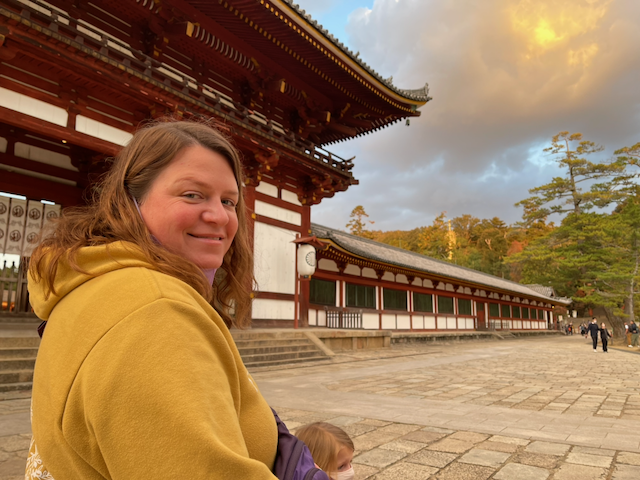
We spent a full day exploring Nara Park with our three daughters during our extended stay in Osaka. The combination of wildlife encounters, ancient architecture, and autumn colors made it one of our favorite day trips in all of Japan. Here's everything you need to know about visiting Nara, from transportation logistics to deer-feeding etiquette.

Getting to Nara from Osaka: Your Complete Transportation Guide
Nara sits conveniently between Osaka and Kyoto, making it an easy day trip from either city. We traveled from our Osaka Airbnb, and the journey was refreshingly straightforward.
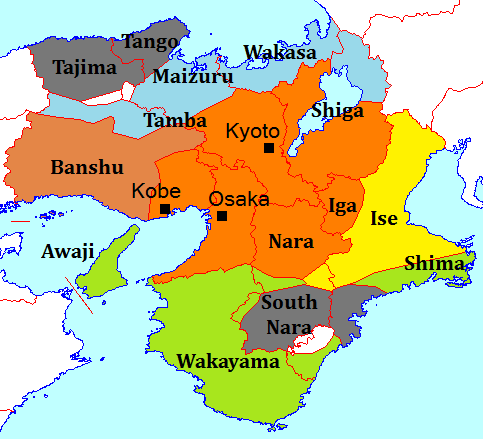
From Osaka to Nara by Train
Kintetsu Nara Line (Recommended)
The Kintetsu Nara Line offers the most convenient option from central Osaka. We took this route from Namba Station, and the entire journey took about 39 minutes to Kintetsu Nara Station. The cost was approximately 570 yen (around $3.80 USD) per person each way, making it an incredibly affordable excursion.
The Kintetsu station deposits you closer to Nara Park than the JR station, cutting your walking time by about 10 minutes. This matters when you're traveling with kids eager to see the deer.
Step-by-step from Osaka:
- Take the subway to Osaka-Namba Station
- Follow signs to the Kintetsu Nara Line platform
- Board a Limited Express or Rapid Express train bound for Nara
- Ride for approximately 39-45 minutes (depends on train type)
- Exit at Kintetsu Nara Station
JR Nara Line (Alternative)
If you're staying near Osaka Station or have a JR Pass, the JR Yamatoji Rapid from Osaka Station reaches JR Nara Station in about 45-50 minutes. The fare runs slightly higher at around 820 yen without a rail pass. The JR station sits about 1 kilometer from Nara Park, requiring a longer walk or bus ride.
From Kyoto to Nara by Train
Kintetsu Line from Kyoto
The Kintetsu Limited Express from Kyoto Station takes 35-45 minutes and costs approximately 720 yen. This route tends to be faster and more comfortable than the JR option.
JR Nara Line from Kyoto
The JR Nara Line connects Kyoto Station to JR Nara Station in about 45 minutes for around 720 yen. Trains run frequently throughout the day, though some require transfers at smaller stations.
Pro tip:
Download the Hyperdia or Google Maps app before your trip. Japan's train system is incredibly punctual and well-organized, but having real-time navigation helps tremendously when coordinating connections.
Walking from the Station to Nara Park
From Kintetsu Nara Station, we faced about a 20-minute walk to reach the main deer area of Nara Park. The route takes you along covered shopping streets that gradually transition into tree-lined pedestrian paths. Even this approach walk offered beautiful scenery, with traditional architecture and early glimpses of deer appearing near the park edges.
The path climbs gradually, and while it didn't feel steep to us, our daughters definitely noticed the incline. The effort proved absolutely worth it once we reached the park proper and saw the first deer grazing peacefully near the pathway.

Nara Tours: Guided Experiences from Osaka and Kyoto
While Nara works perfectly as a DIY day trip, guided tours offer convenience and deeper cultural insights, especially for first-time visitors to Japan.
Early Morning Nara Tour from Kyoto or Osaka
Get Your Guide's Early Morning Nara Tour gets you to the temples and deer areas before the tour bus crowds arrive. Starting around 7:30 AM, these tours let you experience Nara Park in relative peace, with better lighting for photography and deer that are calmer and less aggressive.
Early morning visits mean fewer people competing for the deer's attention with feeding crackers, creating a more authentic wildlife encounter. The tour typically includes Todai-ji Temple, Kasuga Taisha Shrine, and guided deer interactions with proper etiquette instruction.
Full-Day Nara and Uji Tour from Osaka
Klook's Nara and Uji Day Tour combines Nara's deer park and temples with the tea-growing region of Uji. This option works well for travelers who want to maximize their sightseeing without the stress of navigating train transfers.
The guided tour format benefits families with young children or travelers on tight schedules. Transportation, entry fees, and lunch are typically included, eliminating the mental load of coordinating multiple moving pieces.

What to See in Nara Park: Beyond the Deer
Nara Park encompasses over 1,200 acres of greenspace dotted with UNESCO World Heritage sites, museums, gardens, and those famous deer. The park doesn't have a defined entrance or exit, it simply flows from the city streets into forested temple grounds.
Todai-ji Temple: Japan's Largest Buddha
Todai-ji Temple houses the Daibutsu, a bronze Buddha statue standing 15 meters (49 feet) tall. This temple ranks among Japan's most historically significant, originally constructed in 752 CE. The main hall that contains the Buddha is one of the world's largest wooden structures, and the scale hits you the moment you approach through the massive Nandaimon Gate.
The gate itself deserves attention, protected by two fierce guardian statues carved in the 13th century. School groups crowded around us when we visited, evidence of Todai-ji's importance in Japanese cultural education. Our daughters were mesmerized by the Buddha's size, something photographs simply don't capture adequately.
Admission: 600 yen for adults, 300 yen for children Hours: Typically 8:00 AM to 5:00 PM (varies by season)
Inside the main hall, look for the pillar with a hole cut through its base. Legend says that anyone who can squeeze through the opening will be granted enlightenment in their next life. The hole matches the size of one of the Buddha's nostrils, if that gives you any indication of scale.

Kasuga Taisha Shrine: Thousands of Lanterns
Kasuga Taisha, established in 768 CE, features over 3,000 bronze and stone lanterns lining the pathways. The shrine holds special lantern-lighting ceremonies twice annually (in February and August) when all the lanterns illuminate simultaneously, creating an otherworldly atmosphere.
The vermillion-painted shrine buildings contrast beautifully against the surrounding forest. We didn't visit inside during our trip, but the exterior grounds and approach paths alone justify the walk. Hundreds of stone lanterns covered in moss create an ancient, mysterious feeling as you ascend toward the main sanctuary.
Nara National Museum
For those interested in Japanese Buddhist art, the Nara National Museum houses an extensive collection of sculptures, paintings, and ceremonial objects. We skipped this with our young daughters, but art enthusiasts consistently rate it as one of Japan's finest museums.

The Autumn Colors
We visited Nara in November, catching the tail end of autumn foliage season. Japanese maple trees throughout the park displayed brilliant reds and oranges, creating a photographer's paradise. The combination of deer grazing beneath colorful canopies, with temple roofs visible in the background, produced some of our favorite photos from our entire time in Japan.
Spring brings cherry blossoms instead, equally stunning but attracting larger crowds. Summer offers lush green scenery with warmer weather, while winter creates stark, dramatic landscapes with fewer tourists.
The Sacred Deer of Nara: History, Behavior & Feeding Etiquette
Approximately 1,500 sika deer roam freely throughout Nara Park, descendants of deer that have lived in the area for over a thousand years. These deer are the main attraction for most visitors, including us.
Historical Significance
Until 1637, killing one of Nara's deer was punishable by death. The deer were considered messengers of the Shinto gods, particularly associated with Kasuga Taisha Shrine. While they lost their sacred status after World War II, the deer remain protected as a National Natural Monument.
This protection means the deer have become remarkably comfortable around humans. They bow when asking for food, cross streets at designated crosswalks, and generally behave like semi-domesticated animals. Don't mistake this for true domestication though. These are wild animals that can bite, headbutt, and behave aggressively, particularly during mating season.

Deer Feeding: How to Do It Safely
Vendors throughout Nara Park sell shika senbei (deer crackers) for 200 yen per bundle (usually 8-10 crackers). These are the only food you should feed the deer. Human snacks can harm their digestive systems.
Our experience feeding the deer:
The deer spotted our cracker bundle immediately. Within seconds, we went from petting one gentle deer to being surrounded by a small herd, all bowing and nudging us for crackers. The situation escalated quickly from charming to slightly overwhelming.
The deer can be pushy. They'll nibble at your clothes, bags, and pockets if they suspect you're hiding crackers. One particularly bold deer tried to eat the map right out of my hand. We learned quickly that once you start feeding them, you become their primary focus until the crackers are gone.

Safety tips for deer feeding:
- Keep crackers hidden until you're ready to feed. Deer can see the crackers in your hand and will swarm immediately.
- Feed one deer at a time when possible. Hold crackers high so only one deer can reach them at a time.
- Show empty hands when crackers are finished. Most deer will lose interest and wander away once they understand the food is gone. Hold your hands up and out to demonstrate.
- Watch for aggressive behavior during October and November. Male deer enter rutting season (mating season) and can be dangerous. Signs throughout the park warn about this, though we didn't encounter major problems.
- Supervise children closely. The deer can knock over small children, intentionally or accidentally. Our youngest daughter needed constant supervision around the more enthusiastic deer.
- Watch your belongings. Deer will try to eat paper maps, tickets, or anything that resembles food. Keep these items secured in closed bags.
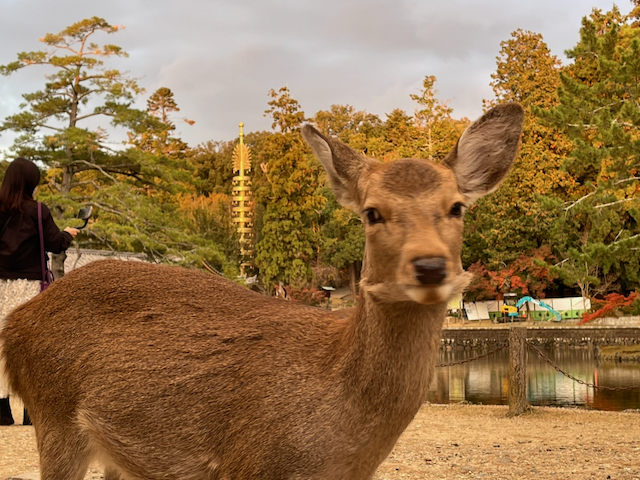
What We Learned About the Deer
During COVID-19, tourism to Nara essentially stopped. The deer had become dependent on tourist-provided crackers as a major food source, and without visitors, many deer began roaming into the city searching for food. Wildlife management teams had to cull some of the population and redirect others back to forested areas where natural food sources existed.
This illustrates an important ecological point: feeding wildlife, even in designated areas, creates dependencies that can harm animal populations when human patterns change. The deer adapted to human presence over centuries, but rapid changes in tourist behavior revealed the fragility of this relationship.
That said, feeding the deer in Nara remains a unique, memorable experience. Just maintain awareness that you're interacting with wild animals that have learned to associate humans with food.
Practical Tips for Your Nara Day Trip
What to Wear
Comfortable walking shoes are essential. We logged over 15,000 steps during our Nara visit, traversing temple stairs, uneven stone pathways, and gradual inclines. The park spreads out over a large area, and you'll do considerable walking between major attractions.
Watch where you step. Deer poop covers many pathways and grass areas. It's unavoidable, just part of the experience. The signage and brochures don't emphasize this detail, but you'll encounter it within minutes of entering the deer areas.
Layers work best for clothing. We visited in November with perfect weather, sunny and about 15-18°C (59-64°F). The forested areas felt cooler than the open spaces, and temple interiors can be chilly. Pack according to the season, but always bring an extra layer.
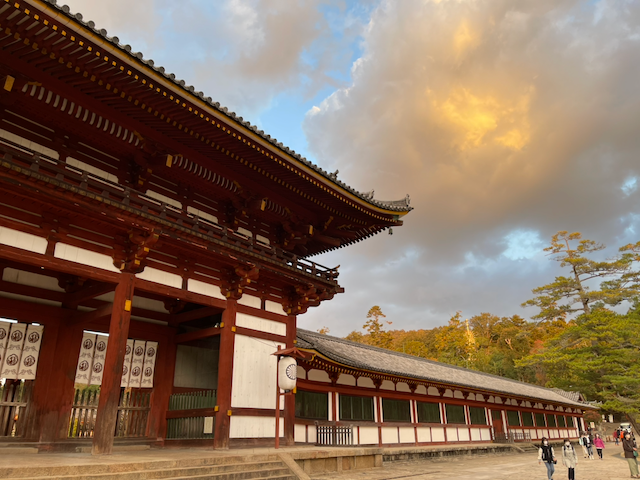
When to Visit
Time of day: Early morning (before 10 AM) or late afternoon (after 3 PM) offers the best experience. Midday brings tour buses and school groups, creating crowds around popular temples and deer feeding areas.
We arrived around 10 AM and found the park already busy. The deer seemed more aggressive during peak hours, likely overwhelmed by constant feeding attempts from hundreds of visitors.
Season: Each season offers distinct advantages. Spring (late March to early April) delivers cherry blossoms but maximum crowds. Summer (June to August) means heat and humidity but lush greenery. Autumn (October to November) provides colorful foliage and comfortable temperatures. Winter (December to February) brings cold weather, bare trees, but the smallest crowds.
Avoid October-November if you're nervous around animals. Mating season makes the male deer more aggressive and unpredictable.
How Long to Spend in Nara
We allocated a full day and felt it was perfect. A minimum of four hours allows you to see Todai-ji Temple, feed some deer, and walk through the main park areas without rushing. Six to eight hours lets you explore more temples, enjoy a leisurely lunch, and really soak in the atmosphere.
Some visitors do Nara as a quick half-day trip, hitting Todai-ji and the deer before rushing back to Osaka or Kyoto. We appreciated having the full day to wander without pressure, especially with children who needed breaks and snacks.
Food and Facilities
Restaurants and cafes cluster near the stations and along the approach to Nara Park. We found a casual spot for lunch with simple Japanese dishes, nothing fancy but reasonably priced and family-friendly.
Within the park itself, food options become limited. Vending machines appear throughout the area, essential for staying hydrated during warmer months. Small cafes near Todai-ji sell ice cream, drinks, and light snacks.
We saw one daughter enjoy a soft-serve ice cream with a chocolate coating and whipped cream, sitting on a bench near the Happy Kitchen cafe. These small moments, taking breaks between temple visits to recharge, made the day more enjoyable for everyone.
Public restrooms appear regularly throughout Nara Park, generally clean and well-maintained like most facilities in Japan.
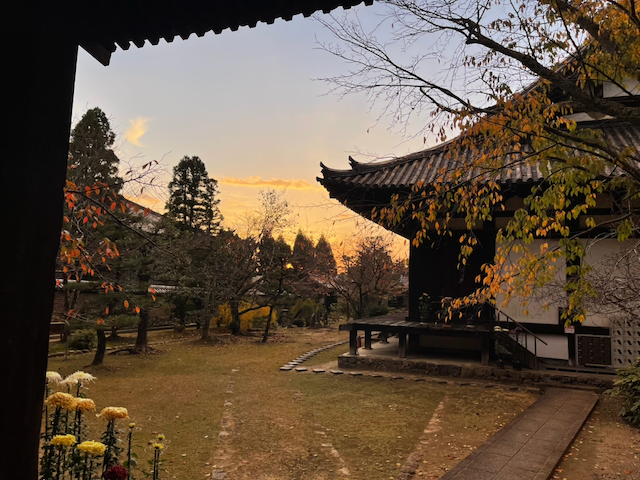
Staying Connected in Japan
Reliable internet access becomes crucial when navigating Japan's train systems and researching real-time temple hours or restaurant options. We used a Holafly eSIM throughout our time in Japan, providing unlimited data without hunting for WiFi hotspots or dealing with physical SIM card swaps.
The eSIM connected to NTT Docomo's network, offering strong coverage even in Nara's forested park areas. This connectivity let us share photos in real-time, navigate to different temple locations, and coordinate our return train schedule without stress.
Use code ADAMANDLINDS for 5% off any Holafly eSIM plan. For trips longer than 30 days in Japan, consider Holafly's new monthly unlimited data plans starting at $49.90/month. You can cancel anytime after the first month while retaining your full 30 days of coverage, offering better value than stacking multiple short-term plans.
Is Nara Worth Visiting?
Absolutely. The train from Osaka cost us about 570 yen each way ($3.50 USD), making it one of the most affordable day trips you can take in Japan. The combination of wildlife encounters, world-class temples, and beautiful natural scenery creates an experience you simply cannot replicate anywhere else.
We traveled with three young daughters, ages 3, 5, and 7 at the time, and they loved every minute. The deer captured their attention immediately, and even the temple visits held their interest thanks to the massive scale of the Buddha and the engaging atmosphere.
Would we visit again? Without hesitation. We spent a full day there and still didn't see everything the park offers. Nara represents everything we love about travel: the intersection of nature, history, and culture creating moments that stick with you long after you've left.
The deer feeding experience alone justifies the trip. Add in Todai-ji Temple's architectural magnificence, the peaceful forest paths, and the stunning autumn colors we encountered, and Nara becomes an essential stop on any Japan itinerary.
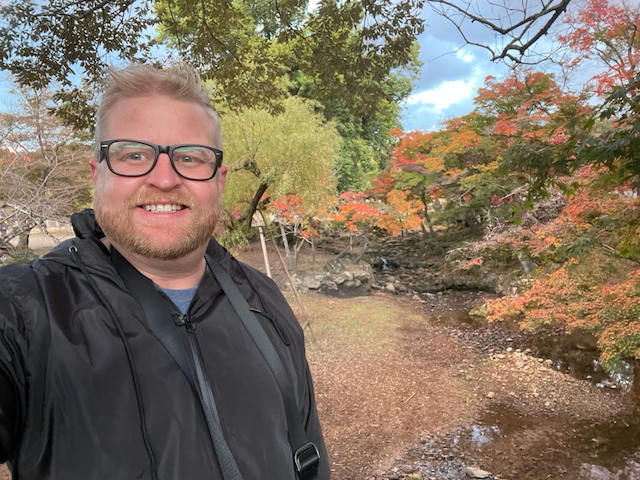
Nara Day Trip FAQ
How much does it cost to visit Nara Park?
Nara Park itself is free to enter. The deer roam freely throughout the public spaces at no cost. Individual temple admissions range from 300-600 yen. Deer crackers cost 200 yen per bundle. Plan on spending 1,500-2,000 yen per person for a full day including train fare, temple entries, and food.
Can you visit Nara in half a day?
Yes, but we recommend a full day if your schedule allows. A half-day visit (4-5 hours) gives you enough time to see Todai-ji Temple, feed the deer, and walk through the main park areas. You'll miss some of the secondary temples and the opportunity to explore at a relaxed pace.
Are the deer in Nara dangerous?
The deer can bite, headbutt, and knock over small children. They're generally safe but still wild animals. Exercise caution during October-November mating season when males become more aggressive. Follow feeding guidelines, supervise children closely, and respect the deer's space when they show signs of agitation.
What's the best time to visit Nara?
Early morning (before 10 AM) offers the best combination of smaller crowds and calmer deer. Autumn (October-November) and spring (March-April) provide the most beautiful scenery, though spring brings heavier crowds. Winter offers the fewest tourists but cold temperatures and bare trees.
Is Nara better to visit from Osaka or Kyoto?
Both work equally well. The train from Osaka (Namba Station) takes about 39 minutes on the Kintetsu Line. From Kyoto, the Kintetsu Limited Express takes 35-45 minutes. Choose based on where you're staying. We visited from Osaka and found the journey straightforward and convenient.
Do you need a JR Pass for Nara?
No, the most convenient train option (Kintetsu Line) doesn't accept JR Passes. The Kintetsu Line costs about 570 yen from Osaka and drops you closer to the park than the JR station. If you already have a JR Pass, you can use it on the JR Yamatoji Line from Osaka or the JR Nara Line from Kyoto.
How long should you spend in Nara?
We spent a full day (about 7-8 hours) and felt it was ideal. This allowed us to visit Todai-ji Temple, feed the deer multiple times, explore the park thoroughly, and enjoy a leisurely lunch without rushing. Some visitors complete Nara in 4-5 hours by focusing only on the main attractions.
Can you bring food into Nara Park?
Yes, you can bring your own food and picnic in the park. However, keep all human food secured in bags. The deer will attempt to eat anything resembling food, including your lunch. Only feed the deer the official crackers sold by vendors throughout the park.
Are there lockers at Nara Station?
Yes, both Kintetsu Nara Station and JR Nara Station have coin lockers available. Prices vary by size (typically 300-600 yen). This lets you store luggage if you're visiting Nara between other destinations or as part of a multi-city day trip.
What should you not do with the deer in Nara?
Don't tease the deer with crackers, surround or corner them, try to ride them, pull their antlers, or feed them human food. Don't let young children chase the deer or approach them from behind. Respect the deer's space and watch for warning signs of aggression like laid-back ears or stomping.
This post contains affiliate links. When you book through our Klook code ADAMANDLINDSKLOOK, Get Your Guide links, or Holafly code ADAMANDLINDS, we earn a small commission at no extra cost to you. This helps support our family travels and keeps our content free. We only recommend services we've personally used and genuinely love.
Watch our full Nara day trip video on YouTube to see our actual experience feeding the deer and exploring the temples with our three daughters.





